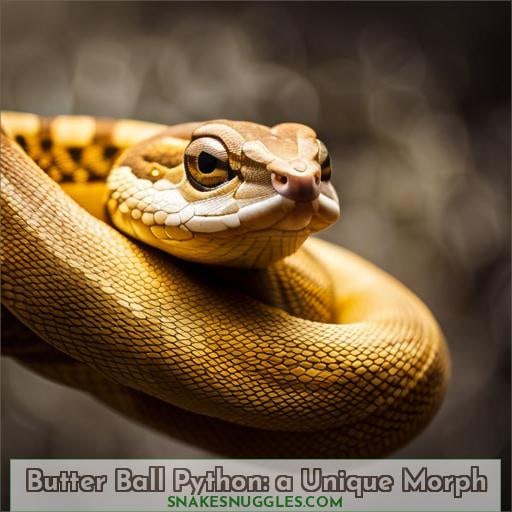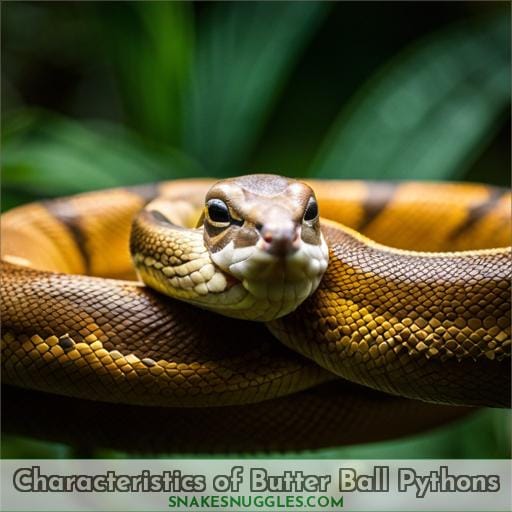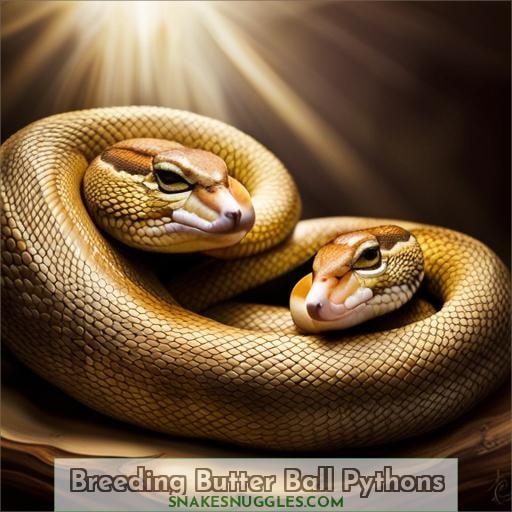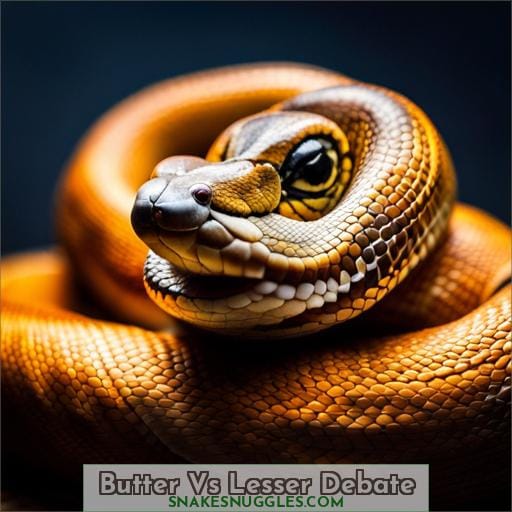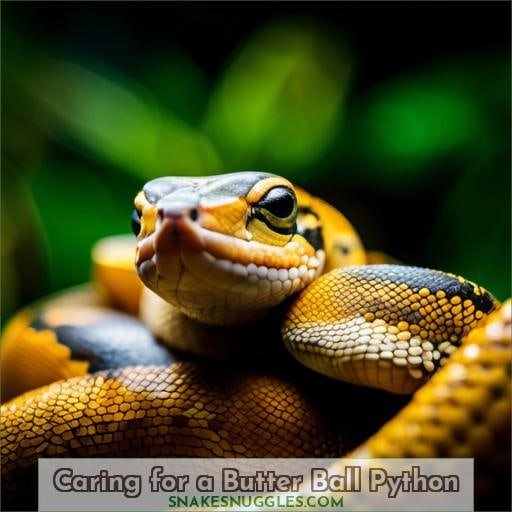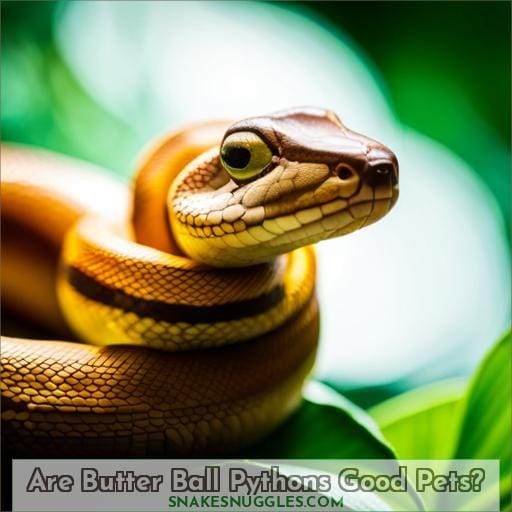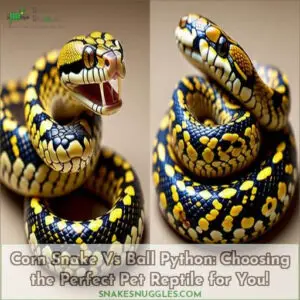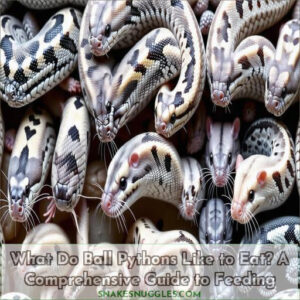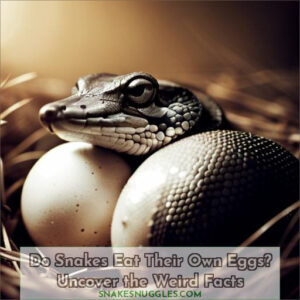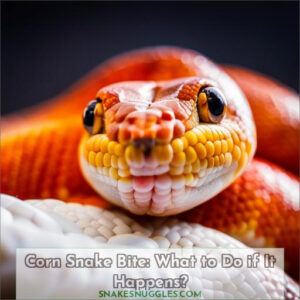This site is supported by our readers. We may earn a commission, at no cost to you, if you purchase through links.
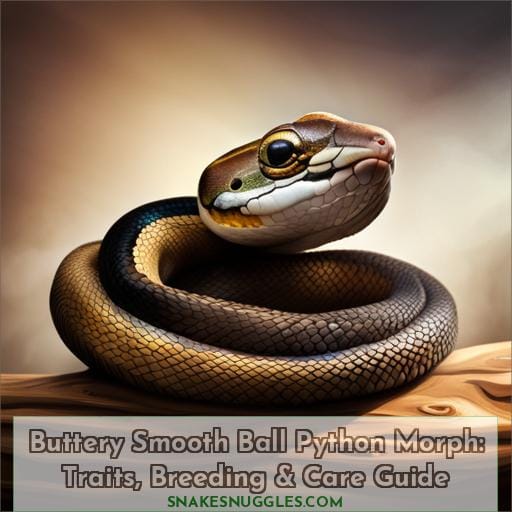 The cunning Butter Ball Python slithered into the hearts of reptile lovers when first revealed in 2001. Like a chameleon, this morph evolved by selectively breeding the original Ball Python until its mesmerizing sheen emerged.
The cunning Butter Ball Python slithered into the hearts of reptile lovers when first revealed in 2001. Like a chameleon, this morph evolved by selectively breeding the original Ball Python until its mesmerizing sheen emerged.
Intimacy with this snake reveals a docile, captivating creature perfect for welcoming into your home. Peel back the scales to uncover everything you need to know to befriend the Butter Ball.
Discover what makes this snake shine brighter than the rest. Learn the ideal habitat for your new cold-blooded companion.
Bond through proper handling techniques tailored to its friendly personality. This article lovingly details all you must understand to build an everlasting connection with an exotic pet.
Become one with the Butter Ball and find the belonging you seek.
Table Of Contents
- Key Takeaways
- Butter Ball Python: a Unique Morph
- Characteristics of Butter Ball Pythons
- Breeding Butter Ball Pythons
- Butter Vs Lesser Debate
- Caring for a Butter Ball Python
- Are Butter Ball Pythons Good Pets?
- Frequently Asked Questions (FAQs)
- What are the average lifespan and health issues of butter ball pythons compared to normal ball pythons?
- How much does a butter ball python cost compared to a normal ball python?
- Are butter ball pythons legal to own in all states in the US?
- How difficult is it for a beginner to care for and breed butter ball pythons?
- What is the temperament of butter ball pythons compared to normal ball pythons – are they more or less aggressive?
- Conclusion
Key Takeaways
- Butter ball pythons have a mix of caramel, creamy black, yellow, and gold markings that make them prized designer morphs.
- Breeding butter ball pythons requires understanding complex genetic inheritance patterns like the outcome probabilities of pairing different morphs.
- Proper husbandry such as temperature gradients, humidity, and suitable substrates is essential for the health and shedding of butter ball pythons.
- Although relatively calm, butter ball pythons can be more sensitive than normal ball pythons, so gentle handling is important.
Butter Ball Python: a Unique Morph
You could’ve picked this unique morph for its golden markings over the usual dull brown. As an experienced keeper, you know this co-dominant ball python requires average skill to thrive. Monitor its health for issues like respiratory infections. Provide proper lighting, heating, and gradients – ideal temps range 78-88°F on the warm end.
This morph originated from the same complex as lesser yet is now considered a separate lineage. Explore designer combos like super pastel to bring out its golden hues. Appreciate how breeding reveals hidden genotypes like blue-eyed leucistics.
In the end, what matters most is appreciating the visual beauty of this golden phenotype.
Characteristics of Butter Ball Pythons
The Butter Ball Python is an attractive morph with unique characteristics. The coloration and pattern of this snake include yellow or gold markings on a brown base, black scales outlining the markings, softer browns closer to caramel in color, lighter tan and gold patterns accompanied by white and black rings, as well as blushing where colors fade into one another.
In terms of size, males reach 2-4 feet long with weights between 1300-1700g, while females are larger due to sexual dimorphism, reaching 4-5 feet long with weights between 1400-1900g respectively.
Coloration and Pattern
Look, friend, the coloring of this snake is a right fine mix of caramel hues with creamy and black accents – it gives it real visual appeal without being too loud.
- Distinct yellow and gold markings
- Black scales outline the pattern
- Blushing where colors fade
- Caramel brown base color
- Creamy tan and gold accents
These unusual color shades and pattern variations make the Butter Ball Python a high contrast, co-dominant morph. Shedding cycles and feeding habits impact the colors. Overall, it has a distinctive ball python morph with creamy toned appeal.
Size and Sexual Dimorphism
You’ll notice male ball pythons average just 2-4 feet long and 1300-1700 grams while females reach a whopping 4-5 feet and 1400-1900 grams. This size difference between the sexes, known as sexual dimorphism, is common in ball pythons.
The largest ball pythons are mature females due to their increased size for reproductive purposes.
Breeding Butter Ball Pythons
When breeding butter ball pythons, you must have a solid understanding of genetics and inheritance patterns, such as the 25% normal, 50% butter, 25% blue-eyed leucistic ratio that results from breeding two butters together.
Butter breeders also aim to produce popular designer morph combinations like butter pastel, cinnamon, mojave, and enchi that showcase the bright gold and yellow tones of this unique codominant mutation.
Genetics and Inheritance
When breeding butter ball pythons, the morph’s codominance means passing just one Butter allele still produces visual Butters in the clutch, while two Butter alleles are needed for the all-white blue-eyed lucies known as BELs to hatch.
- Selecting compatible breeding pairs with desired traits
- Maintaining proper egg incubation temperatures and humidity
- Monitoring females for egg-binding or other health issues
- Using appropriate feeding techniques for hatchlings
- Supporting healthy development as hatchlings grow
Breeding butter ball pythons requires understanding genetics, providing attentive care, and patience as you strive for your desired morph results.
Popular Morph Combos
Feel the richness of a butter pastel’s sunset glow or admire the serene ivory of a BEL pinstripe as you breed your prized pythons.
When breeding butter ball pythons, focus on rare combinations like butter pinstripe, butter phantom, and blue-eyed lucy. But also consider normal genes for healthy babies. Practicing ethical breeding and proper baby care for these caramel-brown beauties is important.
Butter Vs Lesser Debate
You are likely aware that some argue Butter and Lesser Ball Pythons are the same morph with different lineages, while others insist they are distinct mutations. When bred together, Butters and Lessers can produce Blue Eyed Lucies, yet there are subtle differences between their super forms and morph combinations that suggest separate origins despite their similarities.
Similarities and Differences
Some researchers suspect butter and lesser are just different lines of the same morph, though there are subtle distinctions between their super forms and combos you’ll notice. The double genes create different patterns and novel morph combinations like yellow color variations.
However, separate lineages show in pastel, pied, and blue-eyed lucy morphs. Super butter and black pastel combos display subtle lineage differences too.
Breeding Results
Breeding a Butter to a Lesser produces 50% normal, 25% Butter, and 25% Blue Eyed Lucy offspring.
Breeding a Butter to a Butter can result in 25% normal, 50% Butter, and 25% Blue Eyed Lucy babies.
Crossing two Blue Eyed Lucys gives you 100% Blue Eyed Lucys.
Lesser to Lesser results in 50% normal, 50% Blue Eyed Lucy younguns.
The genetic outcomes reveal the shared Butter and Lesser traits. Their combo morphs and super forms demonstrate the subtle lineage differences.
Caring for a Butter Ball Python
When caring for your butter ball python, you’ll need to focus on providing proper habitat and tank setup, understanding their handling and friendliness, and supporting healthy shedding and brumation. This includes setting up an appropriately sized enclosure with hiding spots, a thermogradient, humidity around 60%, and substrates that hold moisture like cypress mulch.
Be prepared for a generally docile, curious snake that may initially be shy but will likely become comfortable with gentle handling.
Pay close attention to their shedding cycles, providing humidity hides, and allow brumation periods of fasting and inactivity through the winter if needed.
With the right habitat and understanding of their needs, butter balls can be rewarding captives.
Habitat and Tank Setup
Providing the right substrate, hides, humidity and temperature gradients in your vivarium lets you successfully house this beautiful morph. Use coconut fiber bedding or cypress mulch to hold humidity. Place hides on the warm and cool sides for proper thermoregulation.
Use a UTH with a thermostat for belly heat. Provide dim lighting and live plants for enrichment. Monitor humidity and offer a humid hide when shedding. With proper habitat setup, your Butter Ball will thrive.
Handling and Friendliness
Welcome, I’ll go ahead and handle this: Despite butter ball pythons preferring to stay cozied up at home, you’d still better detach its vice-like grip jaw from your arm before leaving the house. Butter ball pythons are relatively calm and handleable, though not as tolerant as normal ball pythons.
Their scarcity and popularity for breeding designer morphs like the pastel and pied variations make them sought-after pets for experienced owners.
Shedding and Brumation
Even for a calm fellow, messy sheds and disgruntled fasts test your patience. Maintaining proper humidity with regular misting helps avoid stuck shed. Give soaking baths for removing troublesome stuck shed. Adjust light cycles to mimic seasonal changes, initiating brumation fasts.
Understanding genetic loci and alleles is key to producing the desired butter yellow marked pastel offspring, you dedicated hobbyist.
Are Butter Ball Pythons Good Pets?
You’ll melt at the golden glimmer in its eyes as the Butter Ball Python wraps itself around your wrist, seeking the warmth of a gentle companion. This beautiful snake’s glittery scales call to mind flowing rivers of honey. As you develop a routine of baths, cage cleanings, and regular feedings, you’ll bond with your new pet.
Nervous first-time owners needn’t worry – with proper care, these docile snakes become trusting friends. Their jewel-toned skin entrances hobbyists and experts alike. Hold your Butter Ball close and watch its muscles ripple through a kaleidoscope of lemon and gold.
When its tongue flicks out to taste your scent, you’ll know you have a lifelong companion. This remarkable morph remains one of the most sought-after for its rarity and allure. Let it coil around your heart as you embrace the joy of owning such a treasured snake.
Frequently Asked Questions (FAQs)
What are the average lifespan and health issues of butter ball pythons compared to normal ball pythons?
You might find the butter morph lives just as long and remains as healthy as a normal ball python when properly cared for. Their genetics don’t affect longevity or health, though inbreeding depression can occur.
Providing proper husbandry allows these snakes to live 20-30 years like any ball python.
How much does a butter ball python cost compared to a normal ball python?
Friends, butter ball pythons typically cost $100-300 more than normal ball pythons. Their brilliant gold and yellow markings demand a premium. Yet their rarity and beauty nourish the soul, making them worth every penny.
Are butter ball pythons legal to own in all states in the US?
As an exotic pet owner, you need to check your state’s laws before acquiring a butter ball python. Though popular, these reptiles may face restrictions in certain states. Do your due diligence to ensure legal ownership of these beautiful snakes.
Their alluring patterns could entice, but ignorance of regulations leads to an anxious keeper. Acting lawfully allows you to focus on proper husbandry for a rewarding herpetoculture experience.
How difficult is it for a beginner to care for and breed butter ball pythons?
You can s쳮d, but be ready for commitment! Handling, housing, and feeding are easy, but breeding takes knowledge, skill, and diligence. Stay patient through failures, learn from mentors, and with practice you’ll master gentle pairing, incubating eggs, and raising healthy hatchlings.
What is the temperament of butter ball pythons compared to normal ball pythons – are they more or less aggressive?
You needn’t worry – butter balls are just as mellow as their normal cousins. Their golden complexion belies a gentle heart beneath the scales. Like all ball pythons, they might hiss but hardly ever bite. Their temperament remains unchanged; only their colors are transformed.
Conclusion
Ultimately, the butter ball python’s stunning gold and yellow markings make it a prized morph for any collector. By understanding the genetic intricacies surrounding breeding combinations like butters and blue-eyed leucistics (BELs), you’ll be on your way to producing exotic designer morphs involving this butter ball python.
With proper habitat setup and handling, the butter’s docile nature and unique beauty can make it a rewarding pet.

